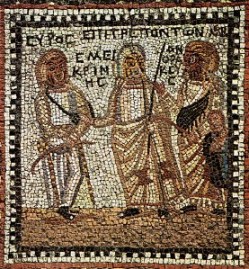
November 22, 2012, by Alan Sommerstein
From Mount Sinai to Michigan: the rediscovery of Menander’s Epitrepontes (part 2)
At St Catherine’s monastery on Mount Sinai, in 1844, Constantin von Tischendorf discovered two leaves of a manuscript containing dramatic dialogue. But they were glued into the cover of another book, and he could only read one side of each leaf. So he did, and took a transcript away with him. And nothing happened; the transcript remained unpublished. As a friend of his wrote after his death:
“Tischendorf, who was entirely absorbed in seeking out and investigating manuscripts of the Holy Scriptures, made no systematic search for classical material of this kind, and discussed it only incidentally.”
In fact he had been intending to publish his new classical discoveries eventually, but he died before he could bring this project to fruition.
Several years after Tischendorf’s visit, Porfiry Uspensky, then the head of the Russian Church Mission in Jerusalem, rediscovered these leaves at the monastery and was able to separate them from the book cover, eventually taking this and many other manuscripts back to St Petersburg. And again nothing happened; the leaves remained in Uspensky’s private collection until he sold it to the Imperial Library in 1883.
Meanwhile, however, something else had happened. In 1876 – a year or two after Tischendorf’s death – the great Dutch scholar, Carel Gabriel Cobet, published a nine-page article in the journal Mnemosyne (from which, indeed, the extract quoted above was taken). That was nothing unusual. He was the senior editor, and that year’s volume of the journal contained no less than twenty-nine separate contributions of his. But this one was something special. The article – written in Latin, like all the others – bore the title “Unpublished Fragments of Menander”, and it began like this:
“It is more than thirty-five years since I established a warm and most pleasant friendship with Constantin Tischendorf, first in Paris and later in Italy, where we were joined by a third very dear companion, Charles Badham. Badham and I made a prolonged stay in Italy; Tischendorf meanwhile travelled through Syria, Palestine and Egypt. From this journey he sent me a little present as a token of friendship – a transcript, from a very ancient manuscript, of the words of an unidentified Greek poet; he did not tell me in what book, or in what library, he had found it. These fragments are on a sheet of paper written in his own hand, on the front of which is inscribed: ‘Two fragments of a very ancient manuscript, apparently of the fourth century.’
“Tischendorf seems never to have thought of publishing these fragments [this is not quite accurate – see above]; but now that he has departed this life, I have decided to do so myself, and to show that they are the work of Menander, taken from two comedies, one of which cannot be identified …”
Cobet thought he could identify the other, and he was wrong (that has turned out to be from Menander’s Phasma or The Apparition) – though he brilliantly proved that the author was Menander, by showing that some lines of this second fragment were identical with the opening of a passage quoted from Menander by the Christian writer Clement of Alexandria. He also wrote some valuable notes on the first fragment, but made no suggestion as to what play it might have come from. Tischendorf’s transcript of it contained nineteen lines; subsequent examination has added small fragments of three more.
It was not until 1891 that the Sinai fragments were published in full, in a study by Viktor Jernstedt, published under the auspices of the University of St Petersburg and entitled, in honour of Uspensky, The Porphyrian Fragments of Attic Comedy. Now about twice as much text was available, but it still could not be established which of Menander’s 108 or so plays it was from, and the new publication made little impact. Perhaps, one must confess, it might have made a little more if Jernstedt had written it in Latin or German rather than in Russian.
Just about this time there began a veritable explosion in the rediscovery of ancient manuscripts preserved in the dry soil of Egypt, including in the first few years several odes by the highly reputed, but hitherto all but completely lost, lyric poet Bacchylides, almost the whole text of an account of the Athenian constitution and its history which was quickly recognized as a work anciently attributed to Aristotle (it is now generally thought to have been written by one of his students), and many other exciting finds. These included, from 1898 onwards, portions of some plays of Menander, but none was very extensive (the longest was about 87 lines), and there was nothing to throw substantial light on the St Petersburg fragments.
Of these fragments themselves, by the way, little was heard for many years, and they were widely believed to have disappeared in one or another of the upheavals that had befallen Russia. In fa ct they had all along been in the same library (later called the Saltykov-Shchedrin State Public Library; now the National Library of Russia) in St Petersburg, subsequently Petrograd, subsequently Leningrad, now again St Petersburg (see http://www.nlr.ru/eng/coll/manuscripts/greek.html).
The great breakthrough for Menander, and for Epitrepontes, came in 1907 with the publication by Gustave Lefebvre of a manuscript found at Aphroditopolis (Gebelein in Upper Egypt), now in the Museum of Egyptian Antiquities in Cairo, which turned out to contain parts of six plays, five of them by Menander. After thirteen centuries in the shadows, Menander had returned to the light in the form of real scripts that could be studied and maybe, with a bit of restoration, even performed on stage. And the best preserved of these was Epitrepontes.
(To be continued)
No comments yet, fill out a comment to be the first

Leave a Reply